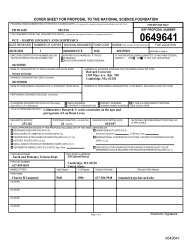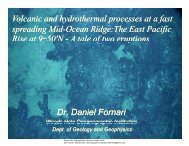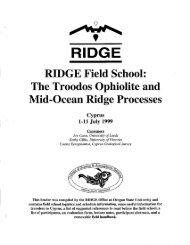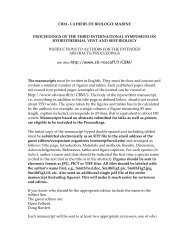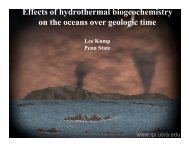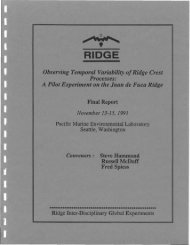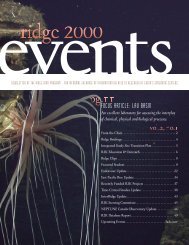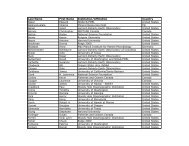You also want an ePaper? Increase the reach of your titles
YUMPU automatically turns print PDFs into web optimized ePapers that Google loves.
On the ridge segment scale, detailed plume mapping probably<br />
by sensors towed from surface ships will inventory the vent<br />
field distribution (both on and off axis ) for comparison to<br />
axial morphology, petrographic heterogeneity, geophysical<br />
variability, and faunal distributions. Techniques of flux<br />
determination developed by the detailed vent field studies will<br />
allow a reliable determination of the total segment - scale<br />
flux. Variability on an annual to decadal scale must be<br />
assessed by repeated surveys of selected segments, although the<br />
contribution of large but infrequent hydrothermal events should<br />
be continuously monitored by an appropriate distribution of<br />
moored sensors. Identification of such events will pinpoint<br />
fruitful locations for geological and geophysical studies.<br />
Basin scale studies have equal along and across-axis<br />
components and are central to the primary objective of<br />
determining the global effect of hydrothermal venting on the<br />
oceanic environment. Along-axis plume surveys, conducted<br />
simultaneously with geophysical surveys and calibrated by a few<br />
detailed segment-scale surveys, will provide a first-order<br />
estimate of the global magnitude and distribution of the<br />
hydrothermal flux. Across-axis surveys of the dispersing plume<br />
will establish the hydrothermal link to oceanic chemistry,<br />
mixing, and circulation. Complementary sediment studies provide<br />
the geologic history of venting.<br />
Data Collection and Measurement Capabilities<br />
We have identified four different scales in space and time<br />
over which data collection must occur.<br />
On the scale of an individual vent orifice or chimney, we<br />
require accurate measurements of the temperature and composition<br />
of the exiting hydrothermal fluids, both high and low temperature,<br />
including an estimate for the hydrothermal end-memberl s)<br />
feeding a vent field. These data are basic for characterizing<br />
the source of any hydrothermal plume. Measurements of mass and<br />
heat flux from individual high-temperature vents are also<br />
essential, along with video recordings of vent orifices to aid<br />
in quantifying the proportion of the total flux which occurs via<br />
hot, focused venting vs. cooler, diffuse venting. Technical<br />
improvements such as acoustic or electromagnetic flowmeters<br />
should be investigated for this application.<br />
On the scale of a vent field, on the order of 100 m x 100 m,<br />
we require detailed mapping of topography, geological and hydrothermal<br />
features, and physical and chemical parameters in the<br />
buoyant, rising plume( s) on a scale of a few meters to a few<br />
hundred meters. Fine-scale measurements of temperature,<br />
velocity. composition, and particle distribution are required<br />
because the rising plume is characterized by large gradients in<br />
space and time. Measurements on this scale should produce the<br />
55




